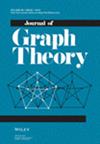On the Ubiquity of Oriented Double Rays
IF 1
3区 数学
Q2 MATHEMATICS
引用次数: 0
Abstract
A digraph is called ubiquitous if every digraph that contains arbitrarily many vertex-disjoint copies of also contains infinitely many vertex-disjoint copies of . We study oriented double rays, that is, digraphs whose underlying undirected graphs are double rays. Calling a vertex of an oriented double ray a turn if it has in-degree or out-degree 2, we prove that an oriented double ray with at least one turn is ubiquitous if and only if it has a (finite) odd number of turns. It remains an open problem to determine whether the consistently oriented double ray is ubiquitous.

论定向双射线的普遍性
有向图H<; math xmlns="http://www.w3.org/1998/Math/MathML" altimg="urn:x-wiley:03649024:media:jgt23216:jgt23216-math-0001" wiley:location="equation/jgt23216-math-0001.png"><mrow>< /mrow></mrow></ mrow></mrow></ mrow></mrow></math>;如果每个有向图包含任意多个顶点不相交的H <;math副本,则称为泛在图。xmlns="http://www.w3.org/1998/Math/MathML" altimg=“urn:x-wiley:03649024:media:jgt23216:jgt23216-math-0002”威利:位置= "方程/ jgt23216 -数学- 0002. png”祝辞& lt; mrow> & lt; mrow> & lt; mi> H< / mi> & lt; / mrow> & lt; / mrow> & lt; / math>还包含无穷多个顶点不相交的H<; math副本xmlns="http://www.w3.org/1998/Math/MathML" altimg="urn:x-wiley:03649024:media:jgt23216:jgt23216-math-0003" wiley:location="equation/jgt23216-math-0003.png"><mrow>< /mrow></mrow></ mrow></mrow></ mrow></math>;。我们研究定向双射线,即有向图H<; math xmlns="http://www.w3.org/1998/Math/MathML" altimg="urn:x-wiley:03649024:media:jgt23216:jgt23216-math-0004" wiley:location="equation/jgt23216-math-0004.png"><mrow>< /mrow></mrow></ mrow></mrow></ mrow></mrow></math>;它下面的无向图是双射线。当一个有向双射线的顶点有入次或出次为2时称其为一个转弯,我们证明了至少有一个转弯的有向双射线是泛在的当且仅当它有(有限)奇数个转弯。确定定向一致的双射线是否普遍存在仍然是一个悬而未决的问题。
本文章由计算机程序翻译,如有差异,请以英文原文为准。
求助全文
约1分钟内获得全文
求助全文
来源期刊

Journal of Graph Theory
数学-数学
CiteScore
1.60
自引率
22.20%
发文量
130
审稿时长
6-12 weeks
期刊介绍:
The Journal of Graph Theory is devoted to a variety of topics in graph theory, such as structural results about graphs, graph algorithms with theoretical emphasis, and discrete optimization on graphs. The scope of the journal also includes related areas in combinatorics and the interaction of graph theory with other mathematical sciences.
A subscription to the Journal of Graph Theory includes a subscription to the Journal of Combinatorial Designs .
 求助内容:
求助内容: 应助结果提醒方式:
应助结果提醒方式:


